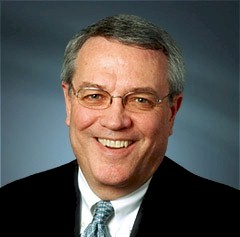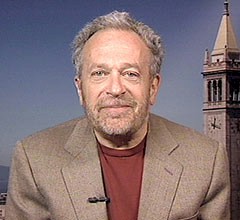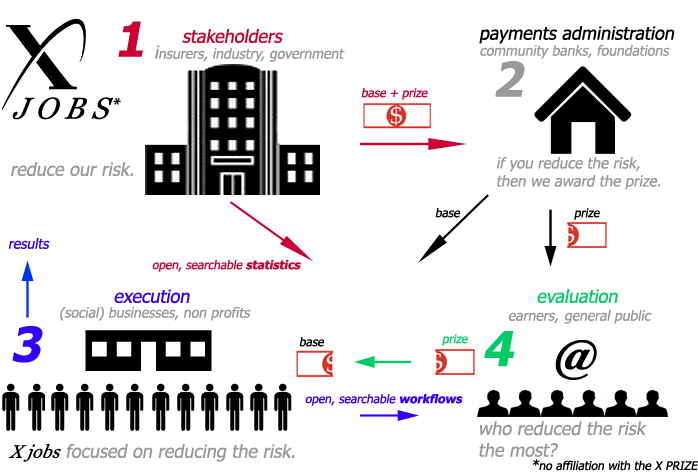X Jobs
Both Robert Reich and Leo Hindery are among the few speaking up to make sure the economy works for you! Outspoken and smart, they’re also very cool, with Leo and his crew winning at Le Mans in 2005, and Robert, more recently, making his hilarious comedy debut with the help of Conan O’Brien.
Unlike the vast majority of people you hear speaking on the economy, they put earners first – with a laser focus on jobs. They get that growth depends on fair distribution of pay.
Listen to how they kept it real, as Leo was interviewed, independently, on the Leonard Lopate Show out of NYC, and Robert was interviewed on the Michael Krasny Show out of SF.
 |
Leo Hindery |
|
Audio clip: Adobe Flash Player (version 9 or above) is required to play this audio clip. Download the latest version here. You also need to have JavaScript enabled in your browser. |
Leo points out that real unemployment in the US is at 20%. The average full time earner only works 33 hours. |
|
Audio clip: Adobe Flash Player (version 9 or above) is required to play this audio clip. Download the latest version here. You also need to have JavaScript enabled in your browser. |
Leo’s turnaround plan calls for large scale infrastructure investment, youth employment and buying domestically to create jobs in the US. |
 |
Robert Reich |
|
Audio clip: Adobe Flash Player (version 9 or above) is required to play this audio clip. Download the latest version here. You also need to have JavaScript enabled in your browser. |
Robert breaks down the various economic factors contributing to consumer (earner) trauma. |
|
Audio clip: Adobe Flash Player (version 9 or above) is required to play this audio clip. Download the latest version here. You also need to have JavaScript enabled in your browser. |
Robert says 23.5 % of pay goes to top 1%. Up from 9% of pay in the 1980s. This is a structural problem that’s been building for years, only now made visible by the Great Recession. |
|
Audio clip: Adobe Flash Player (version 9 or above) is required to play this audio clip. Download the latest version here. You also need to have JavaScript enabled in your browser. |
Robert’s turnaround plan calls for a large second stimulus, resurrection of the WPA, and investments in education, particularly at the community college level. Note: listen closely to the Ivy League/UC Berkeley educated MBA living on 20% unemployment at the start of the clip. More on that later. |
They both agree that the numbers of people in the US out of work is so great (11 million+), that neither the Federal stimulus, nor any bills proposed, are large enough to get everyone back to work. Just like when you need more acceleration to pass the motorist in front of you, they’re calling for more stimulus so we can accelerate through the Great Recession faster, and return to propserity. But, the highway to a second stimulus bill may be closed when we have US Senators blocking the, far less costly, simple extension of unemployment benefits with road signs that say, “tough shit“.
When we’re 11 million jobs in the hole, and we need to create 1.5 million jobs each year, just to keep pace with population growth, we need a Plan B. When unemployment is at roughly 10%, and is projected to remain at 8% until 2014, we need a Plan B.
We need a plan B.
At the start of the third Reich audio clip, you’ll hear an Ivy League/UC Berekely educated MBA, living on unemployment, at 20% of his normal earning. He testifies as to how hard he’s trying to find work, and how little he likes being on the dole. He’s smart. He’s educated. He’s out of work. Why, when education is often given as the key to avoiding unemployment, are so may well educated people unemployed? We offer 3 reasons.
Earners can’t properly plan.
While we can have some idea of what the price and availability of oil, or soybeans will be in a year, thanks to future’s markets; we can’t do so with MBAs or janitors. Odds on every legitimate sporting event are forecast. Weather is forecast and broadcast. Corporate earnings are forecast and broadcast. But, for the most crucial economic indicator in your life, your future earnings, there’s NO forecast!
You can’t blame companies. Chances are they know of potential layoffs long before you do. But, it’s in their best interest to keep the information secret as long as possible, so as to not impair productivity, or trigger an exodus of their best people. If earners want to be able to plan smooth transitions, as companies do, then they”ll need earning forecasting, by occupation and locality. Odds are, they’ll have to build the forecasting system themselves and feed it data too, because no one else will be motivated to do it.
Earners weren’t properly prepared for the future.
Academic degrees have their historical roots in medieval trade guilds, where the emphasis was placed on trade mastery. The top 10 in demand jobs of 2010 did not exist in 2004. This accelerated rate of change means the most important subject to master is the future. We must work backwards from the future, to anticipate problems and jobs that don’t yet exist.
Money that could be used to pay earners is wasted because it’s not time leveraged.
When “An ounce of prevention is worth a pound of cure.” meets “Where’s the pain?”, “Where’s the pain?” usually wins. So, expensive ER and “heroic” medicine prevails over wellness. $23K on average is spent per prisoner vs. $10K per student. And, to quote former US Treasury Secretary, Hank Paulson, “It’s very difficult to get Congress to act on anything that is big and complex and controversial if there is not an immediate crisis”
Given the average cost to educate a student, and the average cost to incarcerate a prisoner, on a GDP basis, we’re better off with more prisoners. Quantitatively this makes sense. But, qualitatively, we know it does not.
It is, in part, because we fail to use qualitative measures that the US economy is rampant with money wasted on later stage crises, that could be use to pay earners; if only it were profitably leveraged at the beginning to reduce the risks in the first place. More teachers are a qualitatively better use of money than more prison guards.
Which brings us to X Jobs. You may be familiar with the X Prize, whose mission is to “create radical breakthroughs for the benefit of humanity thereby inspiring the formation of new industries, jobs and the revitalization of markets that are currently stuck”. They’ve opened the door to a new industry of space tourism through the Ansari X Prize, won by SpaceShipOne. Basically, they offer a $10M prize for any group that is able to achieve a breakthrough, the specifics of which, are layed out by the sponsors of the prize.
X Jobs would follow a similar line, except that rather than emphasize narrowly focused breakthroughs, that typically favor small groups of high earning PhDs, X Jobs would emphasize broad societal risks, that favor large groups of average earners.
For example, car crashes kill about 44K people per year, making it the 6th leading cause of death in the US. About 1/3 of those deaths are caused by drunk driving. The cost to motorists is about $160B per year in lost life, property damage, lost earnings, medical costs and so on. If even a small fraction of this many people were killed in a terrorist attack, we would move heaven and earth to prevent it. But, for some reason, we tolerate these deaths, which occur reliably, like the sunrise, year in and year out.
Let’s take a look at how X Jobs might work for car crashes.
1 Stakeholders: Insurers are paying life insurance, disability, medical costs and property damage claims. Counties and municipalities are paying for medical costs and clean up. Industries are paying with lost earners and lost productivity. These and other crash related costs amount to $160B.
Stakeholders sponsor a prize valued at 5% of what they’re spending now on crashes, in exchange for a 10% reduction in collisions in the succeeding year(s). This amounts to an $8B prize, equivalent to about 3 1/2% of the stimulus at its peak. Essentially, stakeholders would receive a $16B reduction in costs, in return for $8B, or a 100% return on their money.
50% ($4B) of the money is paid out immediately in base pay to fund the effort. 50% is withheld as a prize, only to be awarded, if the reduction is achieved. Sponsors risk a potential loss of $4B, against a potential gain of $8B, should the goal be met.
Open Data: the sponsors also agree to share relevant, real time statistics, such as when, and where collisions occur with evaluators as soon as the data is available.
2 Payments Administration: Unlike the X Prize, X Jobs have many potential winners. Community banks and Foundations with local knowledge act as fiduciaries. They process applications for funding from (social) businesses and non-profits. They administer payments and contribute their knowledge where useful. For this, they take a 5% fee, leaving $7.6B.
3 Execution: Businesses, non-profits like Mother’s Against Drunk Driving and new organizations formed to meet the challenge, apply for and receive base payments. They set about reducing collisions by any legal means necessary. If that means parking outside the bars and clubs at 3AM and offering free rides, that’s what they’ll do. To persuade evaluators that their efforts are more prize worthy than others, they can choose to make what they do transparent and searchable. Openyear can help with that. So, for example, club-to-destination-zip-code GPS record of each drunk person driven home from the club would count in their favor.
4 Evaluation: Earners and the public who are not affiliated with sponsorship, administration or execution are invited to be prize judges. Over the course of the year(s), they follow what people are doing and how the statistics are changing to reach consensus on which organizations/persons are contributing the most towards the overall goal of reducing crashes. The prize (bonus) is awarded to organizations/earners by the Payment Administrator based on their decisions.
If we subtract 1/3 ($2.53B) for execution infrastructure and dedicate the rest to earners, this creates slightly over 100K, $50K jobs. Not much, given how far we are in the hole. But, when you add up all the societal risks we know of that we could tackle with the X jobs model, it easily exceeds the stimulus in sheer dollars. What’s more, it shifts the focus towards where to spend to get the most leverage – biggest bang for the buck – rather than simply levels of spending.
When Eisenhower was US President, we built Interstate Highway infrastructure to better move goods from the State to State. It worked. The US grew. By comparison, the X Jobs infrastructure to move money and information between entities is trivial. Many economists are saying that the US is moving into a permanent condition of high employment. This doesn’t have to be. Reich and Hindery have sounded the alarm. What are we going to do? People dying on the roads and suffering from unemployment can’t wait for Congress. We need a Plan B, and we need it now. We need X Jobs. If you’re feeling us, contact us at info@openyear.org, or sign up at right.



